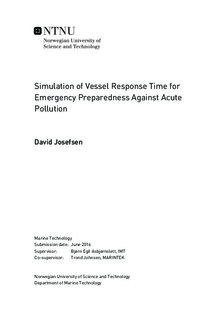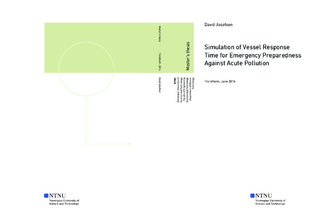| dc.description.abstract | Maritime operations in the far north are not only challenging due to harsh weather conditions, but when engaging in Arctic operations, the remoteness of the area can also be troublesome. In such remote areas, one can no longer take advantage of the area emergency preparedness, where cooperation between geographical areas allows different operating companies to share emergency preparedness resources, such as joint stand-by vessels and SAR helicopters. The demands to emergency preparedness are commonly solved by having a dedicated stand-by vessel positioned close to the platform. The drawback is that chartering such a vessel is costly, and it could be economically beneficial to eliminate the need for this extra vessel. Thus, we want to investigate what oil spill response time can be achieved by utilizing the vessels of the operational fleet for emergency response, in order to remove the supplementary standby-vessel. This leads to the objective of this master s thesis:
The objective of this thesis is to develop a simulation model that can evaluate the expected emergency response time of a given fleet composition, and thus serve as a decision support tool for strategical fleet sizing and operational planning.
In this thesis we limit the investigated emergencies to oil spills. However, the developed model is also applicable to other emergencies, but may require some minor adjustments depending on the incident investigated. Furthermore, the oil spill is assumed to originate from the offshore installation, and for simplicity, this is chosen as the location of the oil spill. Lastly, it is assumed that the operation takes place in an area where no ice is present.
The simulation model is developed in MATLAB as a discrete-event simulation model, and its function is to determine the fastest feasible response time in case of an emergency. That is, the fastest time one of the vessels of our fleet can arrive at the scene of emergency in order to provide the necessary aid.
The model is tested through a case study, where we seek to determine how the fleet response time changes by the number of vessels carrying oil spill response equipment onboard. Through the case study, it was shown that the developed simulation model can be utilized to evaluate different fleet compositions with regards to response time, which can help aid in the decision making when determining the fleet specifications with regards to both emergency preparedness and logistics planning.
For an external reader that wish to utilize this model, it is recommended to include some operational limitations given by weather conditions, such as wave height, and also extend upon the relation between weather conditions and their effect on sailing times. | |

